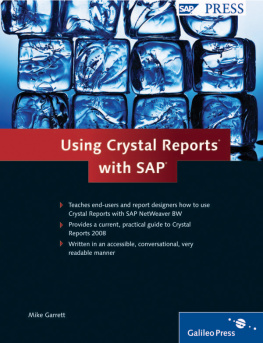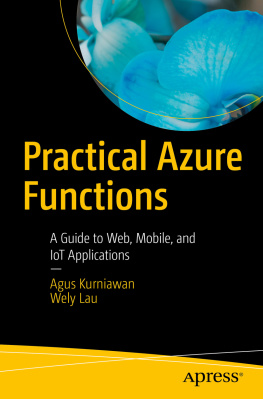Matthias Heiler, Benedikt Kleine Stegemann, Florian Visintin, Thomas Morandell, Holger Wittges, Peter Niemeyer, Burkhardt Funk, Harald Kienegger, Valentin Nicolescu
Practical Guide to SAP NetWeaver PIDevelopment
2nd edition 2010

Imprint
This e-book is a publication many contributed to, specifically:
Editor Stefan Proksch
English Edition Editor Kelly Grace Harris
Translation Valentin Nicolescu
Copyeditor Mike Beady
Cover Design Jill Winitzer
Photo Credit Fotolia
Production E-Book Graham Geary
Typesetting E-Book Publishers' Design and Production Services, Inc.
We hope that you liked this e-book. Please share your feedback with us and read the to find out how to contact us.
Library of Congress Cataloging-in-Publication Data
Praxisleitfaden SAP NetWeaver PI--Entwicklung. EnglishPractical guide to SAP Netweaver PI--development / Valentin Nicolescu, et al.1st ed.p. cm.Includes bibliographical references.ISBN-13: 978-1-59229-334-6 (alk. paper)ISBN-10: 1-59229-334-4 (alk. paper)1.Information technology--Management. 2. Computer network architectures. 3. SAP NetWeaver. 4.Computer softwareDevelopment. I.Nicolescu, Valentin. II.Title.HD30.2.P735 2010005.74dc222010007129
ISBN 978-1-59229-334-6 (print)
ISBN 978-1-59229-683-5 (e-book)
ISBN 978-1-59229-684-2 (print and e-book)
2010 by Galileo Press Inc., Boston (MA)
2nd edition 2010
2nd German edition published 2009 by Galileo Press, Bonn, Germany
Foreword
Even today, there are many companies that still need to integrate their business processes with heterogeneous system landscapes. Therefore, it is important to quickly adapt departmental business processes to new market requirements by standardizing as many processes as possible.
At the same time, there are also a number of individual business processes that distinguish a company from its competitors. In both cases, companies must integrate legacy systems that have been used for many years, but do not support open standards. These systems make it difficult to create a seamless information flow between applications. In addition to pure application-to-application (A2A) communication, companies must also conduct business-to-business (B2B) communication with their business partners.
The challenge of supporting business processes is, on the one hand, the short-term deployment of new processes. On the other hand, companies often differentiate themselves from their competitors by collaborating in networks with business partners to provide their customers with complementary products and services. Innovative solutions that cross corporate, industry, and geographic boundaries are the results of these collaborating organization networks. This has resulted in the evolution of the requirements about how companies work together, provide solutions, and interact with customers. From an integration point of view, standards-based communications, and semantic integration, have become more important.
Companies must often meet these challenges with reduced IT budgets, and economically justify them in the context of business cases. SAP helps companies use appropriate information technology (IT) strategies, especially with regard to the following:
Service-oriented architecture (SOA) as a basic architecture to ensure interoperability and reusability of existing functionality and flexibility.
Service-based business applications, which allow the standardization of business processes and reuse of services.
Model-driven composition of applications for the development of differentiating business processes, to stand out from competitors.
A platform the SAP Business Process Platform for standardized and differentiating business processes to reduce overall costs and simplify management.
SAP NetWeaver Process Integration (PI) 7.1 is, in addition to the SAP NetWeaver Composition Environment, a cornerstone of SOA infrastructure from SAP. The new release of SAP NetWeaver PI represents a natural evolution of previous versions. SAP NetWeaver PI 7.1 is already used by many customers as part of their SOA strategy, thus offering functionalities that are stored in legacy systems in a standardized format via the PI system. In addition, more and more customers are consolidating their heterogeneous middleware environment and using SAP NetWeaver PI as a strategic integration platform.
To ensure compatibility in SAP NetWeaver PI 7.1, no major architectural changes were made. The new SAP NetWeaver PI release provides innovations especially in the following four areas: flexibility and innovation through SOA, improved performance, increased user productivity, and lower overall operating costs.
Some of the fundamentals include the Enterprise Services Repository and Services Registry. The Enterprise Services Repository, which is a natural evolution of the former integration repository, serves as a central repository for storing all SOA artifacts, including semantic meaning. The Enterprise Services Repository allows a model-driven development of services, ranging from model- to proxy-based implementation of the associated business functionality in the application. The Enterprise Services Repository is open for both services that are delivered by SAP, and for services that were developed by customers or partners. The implementation of these services can be located in SAP and non-SAP systems.
The Universal Description, Discovery, and Integration (UDDI) 3.0based service registry serves as a central directory in which the descriptions of all of the service definitions of a customer landscape can be centrally stored, found, and downloaded. A semantic meaning can be attached to services using classifications in the Enterprise Services Repository and the Services Registry. Classifications are delivered by SAP and can also be created by customers and partners.
Another important innovation in SAP NetWeaver PI 7.1 is the increase in performance. This is because of the move from the former Adapter Engine to the Advanced Adapter Engine (AAE). The AAE allows local message processing on the Java stack for certain scenarios, without processing messages on the ABAP stack. This makes message processing up to 10 times faster.
In addition, SAP NetWeaver PI 7.1 provides better user efficiency compared to the previous version. For example, self-developed, Java-based mapping functions can be reused several times without having to copy them. Furthermore, the Enterprise Services Repository supports wizard-based service interface creation from external Web Service Description Language (WSDL) files; multiple WSDL files can be imported simultaneously. The resulting service definitions can be modified and used to generate proxies.
The Integration Directory allows automatic creation of configuration objects based on Process Component Interaction Models, a particular type of model in the Enterprise Services Repository. In addition, validating messages based on XML Schema definitions is offered; this can be used, for example, to prevent payload processing of messages that do not satisfy a pre-defined XML schema definition, thus avoiding unnecessary processor load.
There are also improvements in overall operating costs. For example, SAP NetWeaver PI 7.1 can be installed much faster, now making it possible to install a complete PI system and configure a simple integration scenario in three to four hours. There are also significant improvements regarding sizing, particularly given by the support of a Java EE 5compatible Application Server (AS) Java that uses less memory. Also, the local processing on the AAE leads to smaller sizing.





![Tarik Soulami - Inside Windows debugging: [practical debugging and tracing strategies]](/uploads/posts/book/240776/thumbs/tarik-soulami-inside-windows-debugging.jpg)





